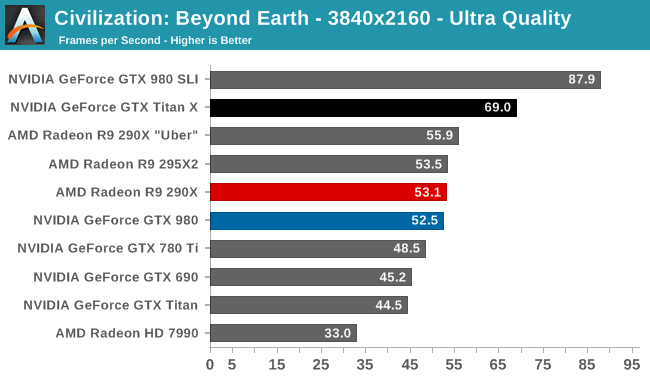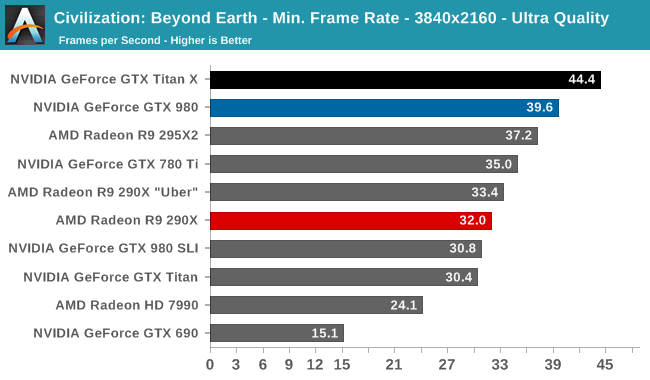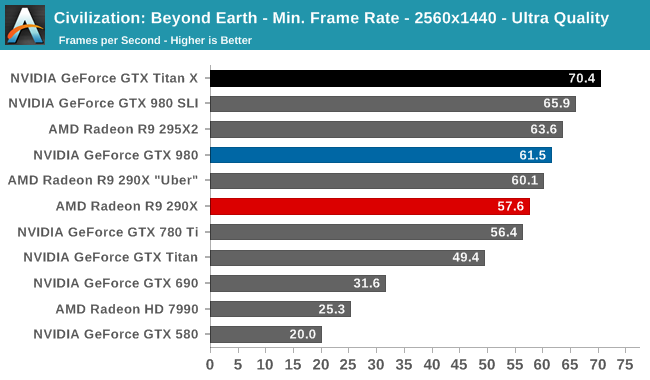The NVIDIA GeForce GTX Titan X Review
by Ryan Smith on March 17, 2015 3:00 PM ESTCivilization: Beyond Earth
Shifting gears from action to strategy, we have Civilization: Beyond Earth, the latest in the Civilization series of strategy games. Civilization is not quite as GPU-demanding as some of our action games, but at Ultra quality it can still pose a challenge for even high-end video cards. Meanwhile as the first Mantle-enabled strategy title Civilization gives us an interesting look into low-level API performance on larger scale games, along with a look at developer Firaxis’s interesting use of split frame rendering with Mantle to reduce latency rather than improving framerates.


Though not as intricate as Crysis 3 or Shadow of Mordor, Civilization still requires a very powerful GPU to run it at 4K if you want to hit 60fps. In fact of our single-GPU configurations the GTX Titan X is the only card to crack 60fps, delivering 69fps at the game’s most extreme setting. This is once again well ahead of the GTX 980 – beating it by 31% at 4K – and 40%+ ahead of the GK110 cards. On the other hand this is the closest AMD’s R9 290XU will get, with the GTX Titan X only beating it by 23% at 4K.
Meanwhile at 1440p it’s entirely possible to play Civilization at 120fps, making it one of a few games where the GTX Titan X can keep up with high refresh rate 1440p monitors.


When it comes to minimum framerates the GTX Titan X doesn’t dominate quite like it does at average framerates, but it still handily takes the top spot. Even at its worst, the GTX Titan X can still deliver 44fps at 4K under Civilization.










276 Comments
View All Comments
Dug - Thursday, March 19, 2015 - link
Thank you for pointing this out.chizow - Monday, March 23, 2015 - link
Uh, they absolutely do push 4GB, its not all for the framebuffer but they use it as a texture cache that absolutely leads to a smoother gaming experience. I've seen SoM, FC4, AC:Unity all use the entire 4GB on my 980 at 1440p Ultra settings (textures most important ofc) even without MSAA.You can optimize as much as you like but if you can keep texture buffered locally it is going to result in a better gaming experience.
And for 780Ti owners not being happy, believe what you like, but these are the folks jumping to upgrade even to 980 because that 3GB has crippled the card, especially at higher resolutions like 4K. 780Ti beats 290X in everything and every resolution, until 4K.
https://www.google.com/?gws_rd=ssl#q=780+ti+3gb+no...
FlushedBubblyJock - Thursday, April 2, 2015 - link
Funny how 3.5GB wass just recently a kickk to the insufficient groin, a gigantic and terrible lie, and worth a lawsuit due to performance issues... as 4GB was sorely needed, now 4GB isn't used....Yes 4GB isn't needed. It was just 970 seconds ago, but not now !
DominionSeraph - Tuesday, March 17, 2015 - link
You always pay extra for the privilege of owning a halo product.Nvidia already rewrote the pricing structure in the consumer's favor when they released the GTX 970 -- a card with $650 performance -- at $329. You can't complain too much that they don't give you the GTX 980 for $400. If you want above the 970 you're going to pay for it. And Nvidia has hit it out of the ballpark with the Titan X. If Nvidia brought the high end of Maxwell down in price AMD would pretty much be out of business considering they'd have to sell housefire Hawaii at $150 instead of being able to find a trickle of pity buyers at $250.
MapRef41N93W - Tuesday, March 17, 2015 - link
Maxwell architecture is not designed for FP64. Even the Quadro doesn't have it. It's one of the ways NVIDIA saved so much power on the same node.shing3232 - Tuesday, March 17, 2015 - link
I believe they could put FP64 into it if they want, but power efficiency is a good way to make ads.MapRef41N93W - Tuesday, March 17, 2015 - link
Would have required a 650mm^2 die which would have been at the limits of what can be done on TSMC 28nm node. Would have also meant a $1200 card.MapRef41N93W - Tuesday, March 17, 2015 - link
And the Quadro a $4000 card doesn't have it, so why would a $999 gaming card have it.testbug00 - Tuesday, March 17, 2015 - link
would it have? No. They could have given it FP64. Could they have given it FP64 without pushing the power and heat up a lot? Nope.the 390x silicon will be capable of over 3TFlop FP64 (the 390x probably locked to 1/8 performance, however) and will be a smaller chip than this. The price to pay will be heat and power. How much? Good question.
dragonsqrrl - Tuesday, March 17, 2015 - link
Yes, it would've required a lot more transistors and die area with Maxwell's architecture, which relies on separate fp64 and fp32 cores. Comparing the costs associated with double precision performance directly to GCN is inaccurate.